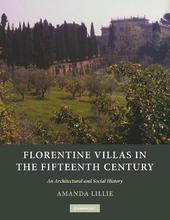
|
Florentine Villas in the Fifteenth Century: An Architectural and Social History
Paperback / softback
Main Details
| Title |
Florentine Villas in the Fifteenth Century: An Architectural and Social History
|
| Authors and Contributors |
By (author) Amanda Lillie
|
| Physical Properties |
| Format:Paperback / softback | | Pages:372 | | Dimensions(mm): Height 279,Width 216 |
|
| Category/Genre | Architectural structure and design
Residential buildings and domestic buildings |
|---|
| ISBN/Barcode |
9780521181389
|
| Classifications | Dewey:720.9455109024 |
|---|
| Audience | | Professional & Vocational | |
|---|
| Illustrations |
Worked examples or Exercises
|
|
Publishing Details |
| Publisher |
Cambridge University Press
|
| Imprint |
Cambridge University Press
|
| Publication Date |
28 April 2011 |
| Publication Country |
United Kingdom
|
Description
In this book, which was originally published in 2005, Amanda Lillie challenges the urban bias in Renaissance art and architectural history by investigating the architecture and patronage strategies, particularly those of the Strozzi and the Sassetti clans, in the Florentine countryside during the fifteenth century. Based entirely on archival material that remained unpublished at the time of publication, her book examines a number of villas from this period and reconstructs the value systems that emerge from these sources, which defy the traditional, idealized interpretation of the 'renaissance villa'. Here, the house is studied in relation to the families who lived in them and to the land that surrounded them. The villa emerges as a functional, utilitarian farming unit upon whose success families depended, and where dynastic and patrimonial values could be nurtured.
ReviewsReview of the hardback: 'This book is the result of a remarkable piece of research that carves out a new and important subject. While it is true that some fifteenth-century Florentine villas have become very well known, these, as Amanda Lillie notes, are principally the five Medici villas at Trebbio, Cafaggiolo, Careggi, Fiesole and Poggio a Caiano, and they are hardly representative of Florentine villa architecture of this time. It is this distortion that the author hopes to remedy by examining some of the 'more ordinary' rural buildings of the period on the basis of detailed and meticulous investigation carried out predominantly in the archive. ... It is a measure of Lillie's scholarly ingenuity that she has succeeded in producing a book that fulfils her stated objective and provides such a wealth of new factual material.' The Burlington Magazine
|